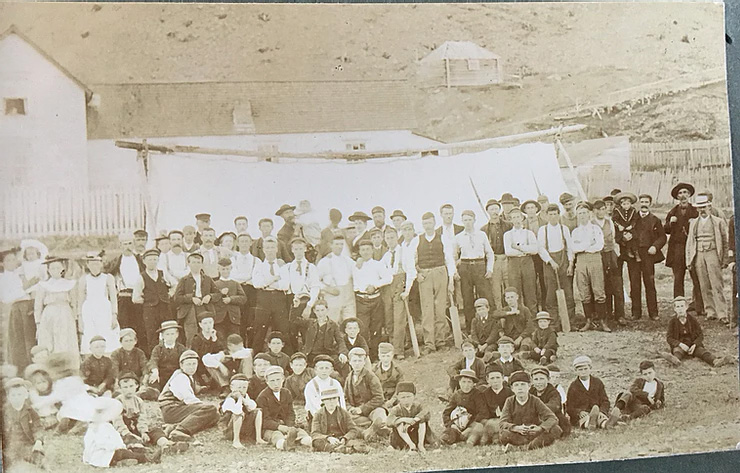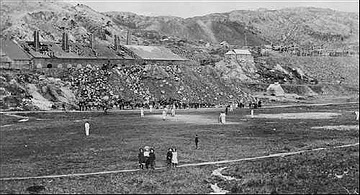 If you’ve ever seen the film The Grand Seduction you’ve probably wondered about historical Newfoundland cricket. I’ve been doing a little digging on it myself and as it turns out it was kind of a big deal!
If you’ve ever seen the film The Grand Seduction you’ve probably wondered about historical Newfoundland cricket. I’ve been doing a little digging on it myself and as it turns out it was kind of a big deal!
Cricket was the most popular sport in Newfoundland during the 19th century. It is recorded on the island as early as 1824 but the game took off in the last decades of that century. It had only a brief popularity in Newfoundland between 1880 and 1910 before being overtaken by soccer. I get the impression that the following generation saw it as a dated game and soccer replaced it as the fashionable game with WWI putting the final nail in its coffin as a generation of young men left for war, many never to return. In Little Bay the game was lost a little earlier and as with most things in the historical town it did not survive the fire.
The game appears to have been favoured by the educated and played mostly by shopkeepers and business owners as oppose to the miners themselves. Cricket was introduced to Little Bay in 1883 by businessman John Lamb who had come to town from St. John’s where the sport had already become quite popular. St. John’s games could amass thousands of spectators and in Little Bay a cricket match would gather the whole population of the town. I am not certain when the cricket season would start but games were played there by July and ended in November
In the 1880s the game exploded across the mining region with competitive teams documented playing against Little Bay from Tilt Cove, Pilley’s Island, Bette’s Cove, and Twillingate. These teams play against each other as well as, in Little Bay’s case at least, against their own amateur team. The competing cricket teams did not function as a league exactly as most matches were the result of direct challenges but nevertheless there was a well monitored hierarchy of victory with Little Bay’s team counted as a worthy competitor.
The new game was the talk of the town by February 1883. However, the first official cricket match did not take place until July 28th that year with one team composed of bachelors and the other of benedicts – unmarried vs married men. The game took on a more professional feel as it progressed with two clubs forming in the town, Pioneers and Notre Dame. The Pioneers, originating with the married men composing the competitive team and the Notre Dame a more amateur team composed of the unmarried gentlemen. There was some movement upward from the Notre Dame into the Pioneers. These Knights of the Willow wore brown Holland costumes with canvas leggings. I believe that cricketer Ernest Berteau contributed to Little Bay’s cricket’s shift toward a more professional feel. His father was the magistrate in Twillingate and their family started cricket there. Magistrate Berteau had taken over the position after Peyton and not only created the town’s cricket field but is recorded as umpiring games there.
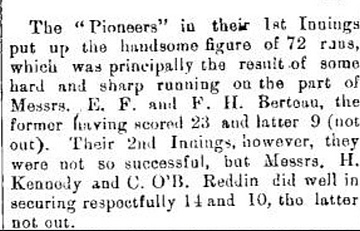 A cricket match was a big deal. Everyone would attend and it would be accompanied by live music from the Little Bay Brass Band. Little Bay’s cricket matches had media coverage in Harbour Breton, Twillingate, and St. John’s. The games were well documented and read about across the island, newspaper articles would give play by play accounts of the game in great detail. When hosting a team from another town the Little Bay club would have a dinner and a bonnet-hop after the game. Bonnet-hops were large social dances at which the women would wear bonnets. Reports on bonnet-hops from St. John’s indicate that these festivities could include fireworks. However, they also involved drinking, a fact which raised social tensions.
A cricket match was a big deal. Everyone would attend and it would be accompanied by live music from the Little Bay Brass Band. Little Bay’s cricket matches had media coverage in Harbour Breton, Twillingate, and St. John’s. The games were well documented and read about across the island, newspaper articles would give play by play accounts of the game in great detail. When hosting a team from another town the Little Bay club would have a dinner and a bonnet-hop after the game. Bonnet-hops were large social dances at which the women would wear bonnets. Reports on bonnet-hops from St. John’s indicate that these festivities could include fireworks. However, they also involved drinking, a fact which raised social tensions.
Not everyone was happy with the sport and in letters to the editor the complaints seem to be aimed at the player’s arrogance, partying, and vandalism. In one letter the writer reported a cricketer he’d “discovered at the silent hour of midnight practicing ‘Yorkers’ on a pump” (Evening Telegram Nov 1883 ). There seems to be some concern over its impact on the public’s image of the town and it is held up against Little Bay’s Reading Room in a type of cultural comparison. I think this is best understood as part of the same conflict seen between Temperance and the Skittle Alley. As I’ve pointed out before, this was a cultural antagonism as oppose to a divide based on class. The split is a result of the town’s Temperance Movement where activities like cricket or skittles became associated with drinking while leisure activities such as attending performances at the Public Hall or studying at the town’s Reading Room did not. The voices from both sides came from educated property owners and in the case of Little Bay’s Masonic Temple at least, representatives from both sides of the cultural divide could be found in the same social club. I’ll remind you that this overlap took place at I time when I believe each group to be responsible for arsons against the other.
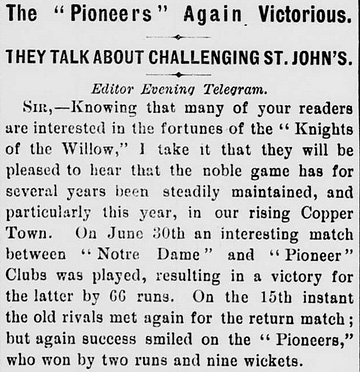 Despite growing tension surrounding the sport, it was an important piece of Little Bay’s cultural architecture and most people attended the games. The town’s cricket field was also used for the town’s various public events including Little Bay’s annual Regatta, celebrations while hosting visiting dignitaries, and during the Queen’s Jubilee in 1887 – a massive event which was celebrated with a variety of sports including a cricket match.
Despite growing tension surrounding the sport, it was an important piece of Little Bay’s cultural architecture and most people attended the games. The town’s cricket field was also used for the town’s various public events including Little Bay’s annual Regatta, celebrations while hosting visiting dignitaries, and during the Queen’s Jubilee in 1887 – a massive event which was celebrated with a variety of sports including a cricket match.
It was printed that Little Bay was selecting a team to challenge St. John’s. At least one newspaper anticipated them potentially winning a championship against the Metropolitan Elevens. “Our young friends there are experts at this ancient or athletic sport, and it is a pity that Little Bay is so far from the capital, as we believe a team of cricketers could be selected there that would carry off the victory even from our Metropolitan ‘elevens’” (Twillingate Sun Sept 1888 ). However, I can find no evidence that such a match took place. The Little Bay team was no doubt severely impacted by the fires and the popularity of the sport on the island took a nosedive after the 19th century.
The Little Bay Pioneers, like any sport celebrities, garnered both praise and jealousy. Below are the team’s players for the years 1884, 1886, and 1888. If you’re ancestor is listed I hope I’ve helped you imagine their experiences a little more and as always if you have pictures or information on them or any other townsfolk please let me know.
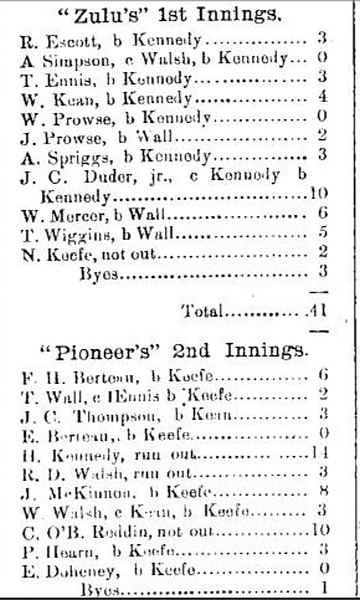 1884
1884
Fredrick. H. Berteau
T. Wall
John C. Thompson
Ernest. Berteau
Hugh Kennedy
Richard D. Walsh
Joseph McKinnon
William Walsh
Charles O.B. Reddin
Patrick Hearn
Edward Doheney
1886
J. Dunn
J. Keefe
Ernest Berteau
John C. Thompson
Hugh Kennedy
P. Dunphy
Fredrick Berteau
Joseph McKinnon
E. Dunphy
Patrick Hearn
1888
John Corbett
T. Dunn
P. Dumphey
James Foley
John C. Thompson
T. Johnston
T. Dennehey
Thomas Hayes
William Lind
William Walsh
Thomas Stewart
The majority of what I have on the game comes from my sources on Little Bay itself. My sources for this piece are almost entirely taken from newspapers referencing Little Bay and I have to thank David Liverman, a man with much more knowledge of the history of Newfoundland cricket, for helping me put Little Bay’s cricket games into some historical context. You can find an article of his on the history of Newfoundland cricket here. I’d also like to thank my friend Doyle Wells, the only other person I know who researches historical Little Bay, for the picture of (what we believe to be) Little Bay’s cricketers that I’ve included below. There is a book called “Recollections of cricket” (1915) by P.J. Myer kept in Memorial University’s Rare Book room that I would like to check for references to Little Bay but I have not yet had the opportunity. I’ll update you with whatever it uncovers.
I hope you found this interesting and as always, thanks for reading!

